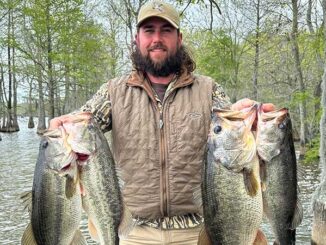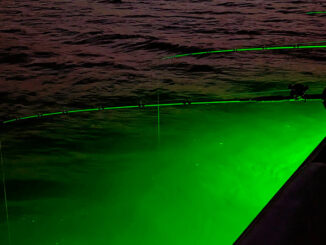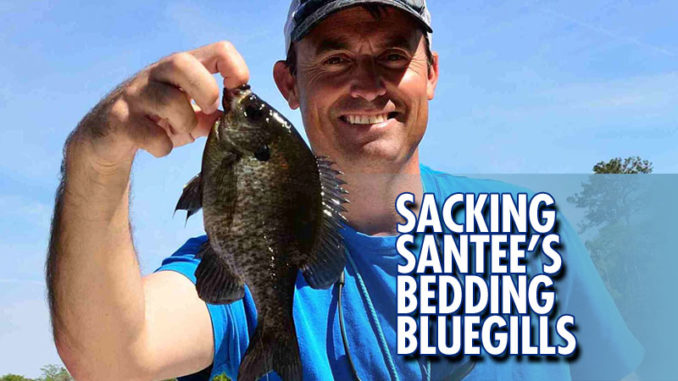
The Santee Cooper lakes’ banks don’t hold all the spawning bream; look for unpressured fish out in open, shallow water for great new-moon, full-moon results.
The Carolinas are blessed with numerous lakes, rivers and a spectacular coast packed with seemingly endless opportunities to wet a hook, but as far as fishing opportunities, it’s usually the big red drum, doormat flounder, chunky largemouth bass and hefty striped bass that bring anglers out of hiding.
One of the most-overlooked fisheries is big bluegill. And summer is prime time to put a Bream Buster to work on bedding bluegills on one of South Carolina’s Santee Cooper Lakes.
Bluegill are most anglers’ “first fish” before they often move on to other, more exciting fish that show up more often in the press. But they are powerful for their size and can be an exciting species to tackle on light tackle in shallow water. Summer is prime time to find a congregation on their spawning grounds. And while Lake Marion and Lake Moultrie are known more for world-record catfish and slab crappie, their 170,000 acres hold healthy populations of pound-plus bream.
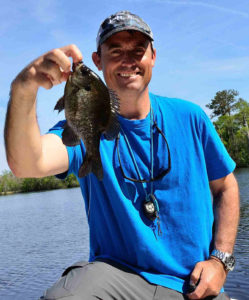
Bluegills are a member of the sunfish family and are found in lakes, rivers, creeks and just about anywhere in North America. During the summer, schools of fish slide onto their spawning grounds and create a colony. Just like largemouth bass, males construct the beds by fanning away the bottom substrate, creating a circular depression to hold eggs. Around the full and new moons, females arrive, packed to the brim with eggs. They soon drop them in the center of the beds and head back to deep water, leaving the males behind to guard the nest.
Forget the shallow banks
Typically, most beds are found in shallow water along the rim of the lakes or edge of the incoming rivers that are often covered in woody and weedy vegetation. But guide, T.C. Lloyd of Southern Angling in Hartsville, S.C., ignores the lakeside border retreats at Santee. Instead, he finds massive schools of bluegill bedding practically in another zip code.
Lloyd spends many days on the water chasing slab crappie in tournaments across the country. But when the summer arrives, he trades out minnows for crickets. And he finds bluegills in places most anglers would never consider even looking.
“I fish Santee Cooper a lot for bluegill, and I find them in unusual places,” Lloyd said. “I find them on main-lake flats and humps sometimes 1,000 yards away from the bank.”
While bluegills prefer to have some cover around their bedding sites to protect their fry, it’s not always required.
“Bluegill will bed around scattered logs and some vegetation on these flats, but most of these flats are bare. They don’t seem to care if they are bedding in the middle of the lake or on the bank. They get little pressure out here, too,” said Lloyd. He finds summer bluegill beds in open water between 3 and 6 feet of water.
Use electronics to find the beds
Often, he finds the fish bedding in the same places each year. But it’s not always that way. If it wasn’t for his high-tech electronics, they would be nearly impossible to locate, especially the ones in deeper water.
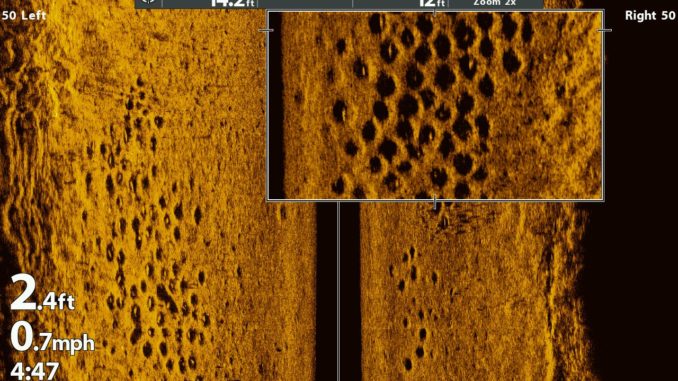
“I couldn’t find them without my Humminbird Helix Mega side imaging. I set my unit to 100-foot out each side of the boat, and I don’t stop until I find them. The beds show up on the screen like a honeycomb on the bottom of the lake. You can even see the fish on the beds, too,” he said.
The side-imaging unit shoots out sonar waves horizontally from each side of the boat. It picks up those bottom contours instead of just below the boat as most traditional down-scanning units do. Lloyd said fish will show up as little, bright-colored marks in the darker, circular depressions.
“We used to drive around on calm, sunny days in the clearest water we could find, standing on seats and the console looking into the water for beds. But side imaging makes it a whole lot easier and efficient for us to find these beds. It’s almost too easy now to find the fish,” he said.
Bream love crickets
Finding the beds is 95 percent of Lloyd’s game, leaving the catching part up to his box of crickets.
“I use crickets mostly. I have caught plenty on jigs and Beetle Spins, but crickets are cheap, and they will hit a cricket every time,” he said.
Tackle for fishing crickets is about a simple as it gets. Lloyd ties on a small, bream hook and squeezes on just enough split shot to sink the cricket to the bottom. For the most part, the large males guard the eggs and will attack anything that tries to eat the eggs. They become very aggressive. So small spinners and jigs worked slowly through beds are great candidates for getting an instant response.
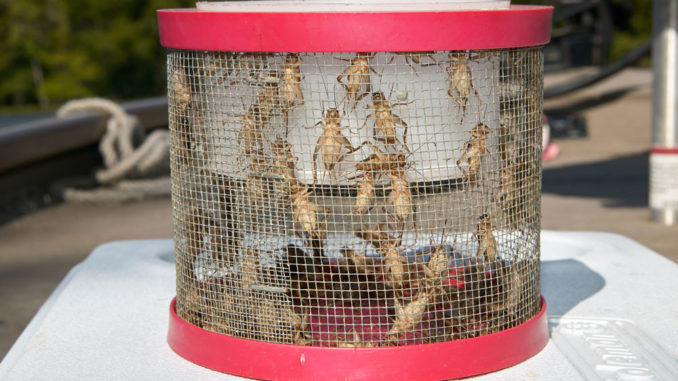
The choice of bait or lures is less important to Lloyd than boat positioning. He urges anglers to keep their distance from an active bed, because these fish can be spooked easily.
“Even though these beds on the open lake are unpressured, bluegills can still be spooky. Don’t cast shadows on them. I keep my distance and cast past the beds and retrieve it back into them,” he said.
DESTINATION INFORMATION
HOW TO GET THERE — The Santee Cooper lakes, Marion and Moultrie, are in just north of I-77, between Columbia and Charleston, S.C. I-77, I-95 and US 52 provide good road access to both lakes, which are connected by the Diversion Canal. Both lakes can be accessed from fish camps along the Canal, and there are dozens of public boat ramps scattered around the two reservoirs, which cover a total of 177,000 acres. For a complete list, visit www.santeecoopercountry.org/listing-item/?type=Lakeside%20Facilities
WHEN TO GO — Bluegill begin spawning in late May and continue through the end of August. The peak spawning period is anytime between June to late July. Three days before and three days after the full and new moon peak is the ideal time to catch bluegills on the beds.
BEST TECHNIQUES — Crickets or worms fished on small hooks under a float or on a bottom rig are hard to beat, but small Beetle Spins or jigs can also fool bedding fish. Fish slowly and cast from a distance. The best rods are small ultralights or fly rods with spinning reels attached. Also, 8- to 9-foot Bream Busters can be used as well. Generally, 6-pound monofilament is about all that is needed to get the fish into the boat without a breakage.
FISHING INFO/GUIDES — T.C. Lloyd, Southern Angling Guide Service, 843-307-6678, www.southernangling.com; Kevin Davis, Black’s Camp, 843-753-2231, www.blackscamp.com. See also Guides & Charters in Classifieds
ACCOMMODATIONS — Black’s Camp, 843-753-2231, www.blackscamp.com; Santee Cooper Country Visitors Bureau, 803-854-2131, www.santeecoopercountry.org.
MAPS — Delorme’s South Carolina Atlas & Gazetteer, 207-846-7000, www.delorme.com; Atlantic Mapping, www.fishingGPSmaps.com.


